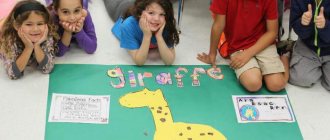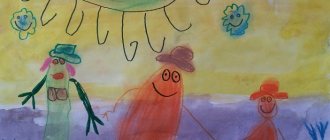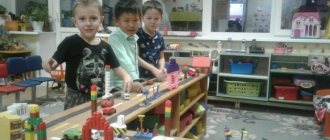Club program “Skillful Hands”
Ekaterina Urzhumova
Club program “Skillful Hands”
CLUB PROGRAM
«Skillful hands»
Explanatory note.
Manual creativity is a type of activity through which skills and abilities, mental and aesthetic development are especially quickly improved. Children with well-developed mastery skills develop speech faster, since fine motor skills of the hands are connected to speech centers. Dexterous, precise hand movements give the child the opportunity to quickly and better master writing techniques. A child is a born designer, inventor and researcher. These inclinations inherent in nature are especially quickly realized and improved in this type of activity. After all, the baby has an unlimited opportunity to come up with his own designs, showing curiosity, intelligence, ingenuity and creativity. In the process of manual labor, performance increases, blood circulation improves, and coordination of hand and eye movements develops. When making crafts, children actively use tools, use them for their intended purpose, learn to recognize the properties of materials, compare them by shape, size, depending on the purpose, size of the craft. The child develops an idea of categories such as size and shape. He learns from experience the structural properties of parts, the possibilities of their fastening, combining, and design. At the same time, as a designer, he creates, learns the laws of harmony and beauty. Children who are interested in manual labor are distinguished by their rich imagination and imagination, the desire to experiment and invent. They have developed spatial, logical, mathematical, associative thinking, memory, and this is the basis of intellectual development and an indicator of the child’s readiness for school.
Purpose of the circle :
Development of children's cognitive, constructive, creative and artistic abilities in the process of creating crafts using various materials and techniques.
Tasks:
Teach children various techniques for transforming paper, fabric, natural and waste materials.
To develop the ability to take into account the specific properties of materials when making crafts from them.
Teach in advance, plan the progress of work on the product (establish a logical sequence for making the craft)
.
Learn to identify work methods and tools, and independently navigate the task.
To develop creative imagination, fantasy, ingenuity, the ability to establish cause-and-effect relationships, cognitive interests and creativity, constructive skills, aesthetic taste.
Develop fine motor skills of the hand, general hand skill , coordination of hand and eye movements.
Develop sensory standards of shape, size, color.
Improve communication skills.
Activate and enrich children's vocabulary. Enrich the gaming experience and create conditions for self-expression and expansion of social experience.
To cultivate diligence, accuracy, and the desire to complete the work started.
Create conditions for positive emotions.
Methods and techniques of teaching.
1. Visual (teacher demonstration, example, help)
.
2. Verbal (explanation, description, encouragement, persuasion, use of tongue twisters, proverbs and sayings, conversation, story, fairy tale).
3. Practical (independent and joint performance of crafts)
.
Preparation of a subject-development environment:
Paper of different formats, colors, quality, colored cardboard;
Paints, glue, scissors, varnish, plasticine, felt-tip pens, pencils, brushes;
Natural material: grains, peas, seeds, etc.
Waste material: threads, buttons, rhinestones, beads, beads, feathers, cotton wool, matches, fabric and
etc.
Class structure:
1. Formation of positive motivation for work;
2. Examination of samples, discussion;
3. Building an action plan ( “what first, what later”
);
4. Choice of material;
5. Finger gymnastics;
6. Independent work of children;
7. Analysis of the finished work;
8. A physical activity or craft game.
Classes are held from September to May, the duration of the lesson is 25-30 minutes.
Working with parents:
Introducing parents to the goals and objectives of the circle and the work plan.
Designing folders of folding beds, information stands for parents, holding
individual consultations in order to expand knowledge about the work carried out with children.
Organization of exhibitions of children's works
Expected results.
Children will know:
- about the variety of materials from which you can make crafts;
— about the properties and qualities of various materials;
- about methods of connecting parts together (using glue, wire, needles, etc.)
— about safety precautions when working with scissors, glue, wire, etc.
Children will be able to:
- plan your work;
— negotiate with each other when performing collective work;
- analyze, determine the correspondence of shapes, sizes, colors, location of parts;
— create individual works;
- use different materials and methods of creating objects;
- use materials carefully and sparingly.
List of used literature
1. Afonkin S. Yu., Afonkina E. Yu. Origami lessons at school and at home. –Moscow: Education, 1996.
2. Gulyants E.K. What can be made from natural materials. –Moscow: Enlightenment, 1984.
3. Magazine “Preschool Education”
No. 3 1990
4. Lykova I. A. Visual activities in kindergarten. –Moscow: Karapuz-Didaktika, 2009.
5. Tarlovskaya N.F. Teaching preschool children design and manual labor. –Moscow: Enlightenment, 1996
September
Topic of the lesson Software content . Material
1st week Introductory lesson.
To develop positive motivation in children in the activities of the circle . Give children the opportunity to see the variety of materials from which crafts can be made, create a desire to experiment with it, identifying properties and connections: Paper, cardboard, plasticine, fabric, seeds and fruits of plants: acorns, chestnuts, bark, branches, seeds, leaves, shells, feathers.
2nd week
"Vegetable Fair"
Continue to teach children how to sculpt vegetables of different shapes (spherical, oval, cone-shaped) and convey their characteristic features. Strengthen the smoothing technique. Plasticine, board, stack, natural vegetables: cucumber, tomato, potato, onion, carrot, beet.
3rd week
"Autumn Pictures"
Teach children to create plot compositions, cultivate a desire to preserve the beauty of nature in arrangements and floral compositions. Leaves of various trees and shrubs, herbs, flower petals, seeds, colored cardboard, glue, brushes, napkins, oilcloths, composition options.
October
Topic of the lesson Software content . Material
Week 1 “Autumn Trees”
Introduce children to one of the types of mosaics -
“mosaic from pencil shavings” -
to consolidate ideas about the signs of autumn; continue to teach children to combine different methods in work to achieve the greatest expressiveness; Paper, gouache, brushes, PVA glue, pencil shavings.
Week 2 “Bouquet of autumn leaves”
To develop the relationship between aesthetic and artistic perception in children’s creative activities. Develop fine motor skills, hand coordination, and eye control.
Cultivate perseverance, accuracy, and the desire to complete the work started. Cardboard, plasticine, stacks.
Week 3 “Fairytale heroes of the forest”
Continue teaching children to work with natural materials. Teach children to make crafts based on drawings, combine different materials in one craft, and fasten them together using sticks and plasticine. Develop creative imagination, fantasy, cultivate artistic taste, patience, attention, observation. Spruce, pine, alder, chestnut, acorns, shells, ash wings, walnut shells, down and feathers of birds, pits of plums, olives, apricots, moss, various seeds.
Week 4 Modeling toys according to children's ideas. Teach children to independently select a topic for work, using their existing experience in creating crafts from natural materials. A variety of natural materials, plasticine, wire, stacks, planks.
November
Topic of the lesson Software content . Material
1st week
"Fish in the Aquarium"
Continue to introduce children to the Japanese art of origami and develop interest in it;
develop in children the ability to work with their hands, accustom them to precise finger movements under the control of consciousness; develop spatial imagination (learn to read drawings)
; strengthen the ability to follow oral instructions; develop concentration and creativity. Colored paper, scissors, pencils.
Week 2 “Duck with ducklings on the lake”
Colored paper, scissors, pencils.
3rd week "Hares in the Forest"
Colored paper, scissors, pencils.
Week 4 “Bullfinches on a rowan branch”
Colored paper, scissors, pencils.
December
Topic of the lesson Software content . Material
Week 1 “Long-awaited guest”
Teach children to make a three-dimensional Christmas tree from a cone and colored strips of the same length. Colored paper (green, scissors, glue.
Week 2 “New Year’s toys”
Strengthen children’s previously acquired skills in working with paper, glue, and scissors; develop a sense of form, color and composition; develop creative imagination, artistic taste, creative initiative. Colored paper; templates of geometric shapes; scissors; braid for making loops; glue; tassels; gouache paints; jars of water; napkins
Week 3 “Garlands for the Holidays”
Develop an interest in working together, cultivate a desire to bring joy to other children. Colored paper, glue, brushes, scissors, oilcloths, napkins, templates.
Week 4 “Ringing bells”
Teach children to create three-dimensional hollow crafts from salt dough;
learn to sculpt a bell from a ball by pressing and modeling the shape; show different techniques for decorating figures. Sample, finished dough, stacks, ribbons, boards, napkins, decoration material (beads, cereals)
January
Topic of the lesson Software content . Material
1st week “Matching a needle with a thread” (threading a needle; sewing on buttons)
Continue to introduce children to sewing accessories: needle, thread, pincushion;
learn to measure the required length of thread; learn to thread a needle and tie a knot at the end of the thread; learn firmly, sew a button with a different number of holes (2 and 4)
to a piece of fabric; consolidate knowledge of safety rules when working with sewing accessories and scissors; Scissors, a needle with a pincushion, a spool of thread, a scrap of fabric, a button.
Week 2 Introducing the needle -forward
Teach children to freely use a needle, sew with a seam:
“needle forward”
, from right to left.
“Forward needle”
seam , thread, scissors, needle with pincushion, scrap of fabric.
Week 3 Introducing the new over-the-edge
“over the edge”
seam , teach them to sew from bottom to top, moving from left to right, continue to teach them how to handle a needle correctly.
Sample of a seam “Over the edge”
, thread, scissors, needle with pincushion, scrap of fabric.
Week 4 Introducing the “Double Seam”
Introduce children to the new “Double Seam”
, help to understand that it is performed on the basis of the
“Forward needle”
;
continue to teach children to sew with even and uniform stitches. Sample of “Double seam”
, thread, scissors, needle with pincushion, scrap of fabric.
February
Topic of the lesson Software content . Material
1st week “Magic plates” Develop a sense of shape, color and composition; creative imagination, artistic taste, creative initiative. Paper plate, colored paper, glue, scissors
2nd week Greeting card for Defender of the Fatherland Day. Learn to think about the content of a postcard, use a variety of cutting techniques. Learn how to beautifully arrange an image on a sheet of paper. Sheets of thick paper, templates, colored paper, scissors, glue, brush, oilcloth, sample.
Week 3 Making Crow
and
“Filin”
Teach children to make a three-dimensional toy based on a cylinder, improve their skills in working with scissors. Colored paper, scissors, glue.
4th week Gift for mom. "Macaroni bouquet"
Continue to teach children how to make pasta appliqué, the basic methods of gluing, and how to correctly place small parts on a craft; instill in children the desire to bring joy to their relatives by making a gift with their own hands. Colored cardboard 15*20, colored paper, flower-shaped pasta, glue, gouache, deep bowls, brush, water, newspaper.
March
Topic of the lesson Software content . Material
Week 1 “Lost Kittens”
Continue to teach children to trace the silhouette along the contour, work with cotton wool, evenly distributing it along the entire contour. Colored cardboard, silhouette image of a kitten, colored paper, cotton wool glue, scissors.
Week 2 “Doll made of colored yarn”
Teach children the simplest way to transform yarn into a souvenir doll, and independently use the decorative elements of a craft. Colored yarn, scissors, colored paper, glue.
Week 3 “Woven bookmark”
Teach children to weave paper backing with strips of colored paper. Colored paper, scissors, glue.
Week 4 “My favorite fairy-tale hero is Dunno”
Continue to teach children how to make crafts in the origami style, combining the following techniques: “making a square from a rectangle”
,
“bending a corner”
,
“crumpled lumps”
,
“the basic form of origami is a door”
. Colored paper, scissors, glue, pencil.
April
Topic of the lesson Software content . Material
Week 1 “Fun Zoo”
Teach children independently, using various cereals, to convey the characteristic features of the appearance of animals. Outline images of animals, glue, various types of cereals, scissors.
Week 2 “Bird of Happiness”
Based on the impressions received (in the process of preparatory work)
propose to create an image of a fairy-tale bird in the application, using decorative elements yourself.
Show how to cut out a silhouette of a bird from paper folded in half. An exhibition of works on the theme “Fairytale Birds”
made in different ways.
Audio recording “Bird Voices”
,
“Sounds of the Forest”,
etc. Colored cardboard, strips of colored paper, confetti, glue, glue brush, scissors, napkin.
Week 3 “Bead Bracelet”
Introduce children to this type of artistic creativity, such as beadwork, and teach them how to make a simple bead decoration.
Multi-colored beads, thin fishing line (thread, scissors.
.
Week 4 “Beads as a gift for mom”
May
Topic of the lesson Software content . Material
Week 1 “Toy for playing with the wind”
Continue to teach children how to fold paper in different directions (origami, analyze a drawing and create a craft using it. Paper (A4 format, strips of corrugated paper, glue, brushes, napkins, scissors.
Week 2 “Birch”
Develop a sense of shape and color; creative imagination, artistic taste, creative initiative. White cardboard, black paper, double-sided colored paper - green, glue, scissors
Week 3 “Sunflowers”
Continue learning to cut out silhouette images along the drawn outline; consolidate the skills of independently making crafts according to a sample. Colored paper, cardboard, sunflower seeds, glue, scissors.
Week 4 “Chrysanthemums”
Introduce children to a new way of making flowers in origami style.
Colored paper, scissors, glue.


